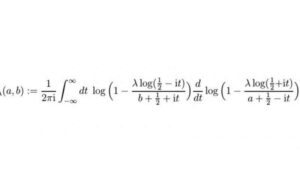Emotions as Math

One of the essential parts of psychotherapy is to start to understand your own feelings and ideas a little more clearly. It is crucial, then, that with most of my clients I am spending some time teaching them about the connections between thoughts, feelings, bodily sensations and actions, since for many people, the idea that they are interconnected that be itself eye opening. I want to get people noticing the way they lead into each other, and to start tracking this stuff to bring it all into greater awareness. This is the core of CBT (cognitive-behavioural therapy) as well as ACT (acceptance and commitment therapy). As I do so, I often come back to the useful idea that emotions are like math equations.
How do I mean that? Well first, we need to start with the notion that emotions themselves are made of cognitive material. Not necessarily conscious cognitive material, but belief and ideas that are under the surface, for sure. This is a hot topic for debate in some circles, as people like to separate emotions from logic or ideas. But though this separation can be useful in some practical scenarios, it is not essentially true. To believe that emotions are totally irrational or primal allows us to conveniently throw them away if we are trying to be intelligent and logical beings. However, this is a perfect example of throwing out the baby with the bathwater. If we ignore the essentially mental basis of emotion, we are cutting ourselves off from understanding.
People have historically been confused by the question, “which comes first, the emotion or the thought”. Some theorists have observed their own behaviour and mistakenly said, “Well, I feel things first before I ever think about them, so emotions must be primary.” Neuroscience suggests a bottom-up theory that instinctive physical reactions lead to thought – which is true for conscious thought, but not the entire picture if we consider a broader scope of mind. If you slow down and look at an emotion in super slow motion, you will notice that 100% of the time, the emotion rises up out of an idea of the situation. Or, another way to notice the truth of this is to see that if your ideas about a person or thing change, then your emotions also change. Seems obvious when you put it like that, right? Emotions occur before our conscious thoughts about a thing, but exist only because of previously present ideas, which we can discover by self-reflection after or even during the experience of the emotion.
Though there is significant evidence that conscious ideas are formed only after information is passed on from the neural activity of systems in the gut and viscera, it also is true that when deep, subconscious about beliefs change, then even our visceral reactions change. Your reaction to a snake might be very different from mine, or from Steve Irwin’s. Same goes for a kitten, a piece of music, a bottle of beer.
The way I see and explain this to clients is that I ask them to imagine an emotion as a really complex mathematical equation. Something like this:
 Now, I don’t understand what any of this means so please – mathematicians out there, please forgive me the simple illustration. But depending on what some of these variables represent, there could be huge amounts of information stored in a single equation like this. One of those letters could represent another whole system, and one of those brackets could be a reduction of pages worth of numbers and ideas. Well, the way I see it, emotions are just like this. We contain a vast amount of cognitive information within us, and it is far, far too much to be conscious of in any given moment. When your mother looks at you a certain way and you feel annoyed, we could see that your annoyance is essentially a mathematical equation: (ANNOYED), and every letter in this is a variable that represents tremendous information – the A stands for every time your mother previously has looked at you like this, the N stands for every possible outcome that you have had from such experiences, etc. Because so much information exists in the single moment of your mothers glance to you, your body/ mind system needs a way to convey that information to you very quickly so that you can react and not have to break it all down through conscious thought, which is far too slow for crucial reactions.
Now, I don’t understand what any of this means so please – mathematicians out there, please forgive me the simple illustration. But depending on what some of these variables represent, there could be huge amounts of information stored in a single equation like this. One of those letters could represent another whole system, and one of those brackets could be a reduction of pages worth of numbers and ideas. Well, the way I see it, emotions are just like this. We contain a vast amount of cognitive information within us, and it is far, far too much to be conscious of in any given moment. When your mother looks at you a certain way and you feel annoyed, we could see that your annoyance is essentially a mathematical equation: (ANNOYED), and every letter in this is a variable that represents tremendous information – the A stands for every time your mother previously has looked at you like this, the N stands for every possible outcome that you have had from such experiences, etc. Because so much information exists in the single moment of your mothers glance to you, your body/ mind system needs a way to convey that information to you very quickly so that you can react and not have to break it all down through conscious thought, which is far too slow for crucial reactions.
This is especially clear when you think of the primary emotions and how they relate to our evolution and survival. Hearing an indistinct rumble in the bushes requires you to process a vast amount of information so that you can consider whether to run away, prepare to fight, or know that your friend’s belly is hungry. None of that is conscious. Similarly, it is essential to make quick decisions about whether or not you really like a person, or consider them a threat. All these responses are ones that we tend to use emotions for, primarily, and for good reason. That is not to say that our emotions are perfect conveyors of truth, and I want to make that very, very clear. Emotions are perfect conveyors of our innermost beliefs and ideas about a thing, though, and that is super useful.
Emotions are not proof that an idea is accurate, only that you believe it.
That is essential to know! I could also write a math equation that was completely false. But that wouldn’t stop it from looking like a math equation!
So if we go back to that lovely mathematical equation above, I want you to notice that you probably don’t have any idea what it might be referring to. I certainly don’t. For a moment, just look at the equation and appreciate it as an interesting picture, as if you didn’t even know what numbers meant at all, like you were looking at it with the eyes of a baby. In this way, it is just a bunch of shapes. It is art! It has an instant effect on you. Perfect. Job well done! We don’t need to know the precise information that it is pointing to, we just need to feel the equation – how elegant and useful! That is what emotions are.
Now, our job as intelligent and self-aware beings is to get curious about the equation, to start to solve it. What does it really point at? What does ‘a’ really stand for? When we slow things down and really listen, we will always find that our emotions are heavily layered with ideas about yourself, the world, and the situations they arise in. And if we want our reactions to things to change, it behoves us then to examine the ideas behind the emotions, and use honest inquiry to reveal its flaws and unhelpfulness. It is work! We have to break down the equation and see it for what it really is.
To continue the metaphor of numbers, I would go on to say that as we break down the equation, we first find greater complexity, but eventually it becomes simpler. Meaning, as we might examine your emotions in therapy or self-introspection, we might first find what look like hundreds of ideas with slight variance on themes embedded in the feeling. And all of these ideas might have your own personal spin on them, based on your own history and experience. This is where there is huge complexity.
However, as we drill down into these thoughts, it seems that these too are made of seemingly essential ingredients that are common to all human experience, just as all math can be boiled down to expressions using the digits 0-9. (Now, I suspect that this is not absolutely true, since math can get really wonky, but I think it is true enough to serve our example). So I’m trying to show that even in the infinite variety of thoughts and ideas about the world that percolate into your own feelings about your own father, your lover, about snow, about puppies and cleaning dishes and Mozart – there seems to be some fundamental (and perhaps irreducible) concepts about existence that we always encounter at the root.
It seems that these ideas are those such as:
- I need, want, or must not have this or that.
- I am not good enough.
- I am just a body
- The world is separate from me
- I need x,y, z to be ok.
- There is not enough (of x, y, z)
I wonder, in writing this, if I might be making a mistake in attempting to reduce emotions to math, even just for the purpose of teaching and example. But I also wonder if there truly might be something essentially numerical in our basic thought patterns. We could consider our essential, undifferentiated self as the zero, and as some cosmologists do, look at the big bang or original sin ideas as the stepping of zero to 1, and from 1 to 2, each one of these steps being some kind of movement of thought. In a mental universe, after all, numbers are not just ideas, but ideas are numbers too.
I’m no mathematician, but I have such admiration for, and trust in, some of the minds which show us that there is some undeniable connection where math expresses reality itself. Why would we believe that this would apply to the domains of plants, planets and probabilities, and not to more human issues? From what we have seen, it is just as likely that we just have not discovered applications in these more human, abstract and mind-bogglingly complex realms as emotion and idea. But if we could translate number to idea – or rather, if we could interpret the idea of numbers – in a more philosophical sense, I wonder what we could learn about ourselves? The natural world is not separate from us, after all, neither in flesh nor in thought. Errors of human relationship are failures to balance equations just as much as are mistakes in math.
I don’t believe any of this needs to take the heart out of us, though. In fact, I suggest pursuing logic and critical thinking with total discipline. In which case, we can’t let mere belief or cultural norms get in the way. My experience is that if we use pure logic, we actually can’t ignore the love at the core of it all. We don’t need faith or blind trust to see that connection is the fabric of existence, and we don’t love a person or thing any less when we understand why we do so. In fact, it seems to me that love and peace become incredibly strong when they are arrived at by logic and intelligence. Doesn’t the world show us, again and again, the healing power of love, the beauty in connection, and the mathematical soundness of principles and formulas that unite? If we look at the stories of the world, all the great archetypal patterns playing out in mythologies, narratives, plots of every real and fictitious kind, do they not speak of universal principles that are not just man-made abstractions, but observable tendencies of nature? And of these tendencies, do we not see again and again, that when we act from a place of separation, those actions lead to what we subjectively call ‘bad’, and when we act from connection, that leads to what we subjectively call ‘good’? Maybe all of this is a perpetual hint of what it is all about. And because it is built into the very nature of reality, into your own nature of being, then every single thing that you ever do will continue to give you results that push you in that direction. Life is a foolproof and failsafe mechanism. We repeat until we learn, and it is all the same lessons, and variations on a theme.
And maybe it is all just basic math. As I wrote in my first book, if you take everything in the universe and add it all up, the number you get is 1. But maybe I should adjust that. Because 1 without another has no context for it to be 1. So maybe it is just 0. The great empty void, and potential of infinity.
You + me + everyone + everything = 1. And when there is nothing left but one, there is really zero. And maybe that is the entirety of creation right there – the inbreath and the outbreath of God, as they say. The way that 0 reaches out to infinity and falls back to itself again. And again and again and again. In every moment!
And maybe we can feel that. It is not loud though. It is the most subtle thing. And when we still ourselves, it is the softness that connects us to everything else. Maybe so subtle that it is not rightly called a feeling. Just a knowing of our own being.
Maybe the universe, and therefore ourselves, could be seen as complex mathematical equations that are on their way to maximal complexity and then back to simplification again. Maybe that is what all our work is about. The people who are most sincere in their spirituality seem to be the ones not trying to add to their being, but subtract.
As the Tao Te Ching says, “in pursuit of knowledge, every day something is added. In pursuit of the Tao, every day something is dropped”
What happens when everything that can be let go of, is let go? What are we left with? Whatever it is, it is the substratum of ourselves, our true nature. It is the white space of the page that holds the math equation itself, it is the part of you that notices and allows your emotion. When we can see beyond the feelings, ideas, and math, we can get in touch with the part of ourselves that is impervious to the pushes and pulls of emotion. This is our place of peace. This is the place that we feel in our best moments, and that we can learn to anchor in, more and more.
Let’s listen, then, to our emotions. Not because they are ‘truth’, but because they are both made of it, and obscure it as well, just like the clouds seem to obstruct our view of the sky, but are made of the sky as well.
There is logic and intelligence, even in the seeming irrationality of our emotions. Let’s embrace them for what they are, and listen with sincerity, honesty, and courage. To simplify, to make our lives clearer and easier – this is something that I suspect we all want.



